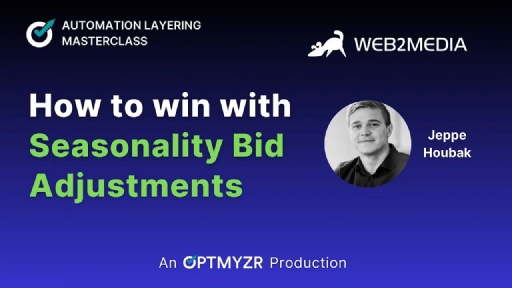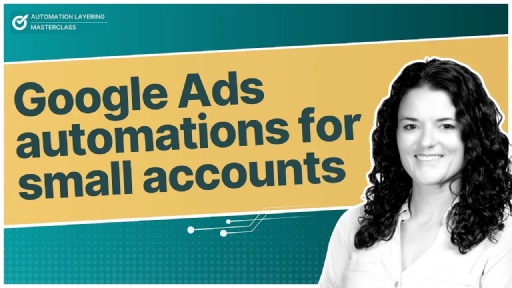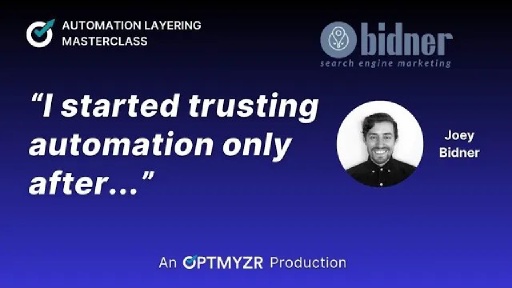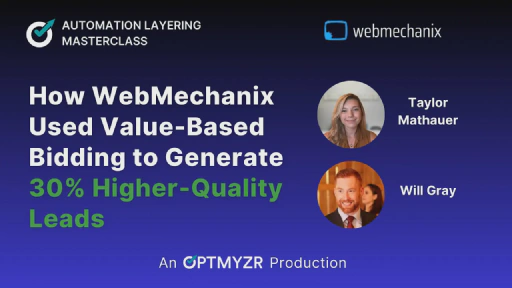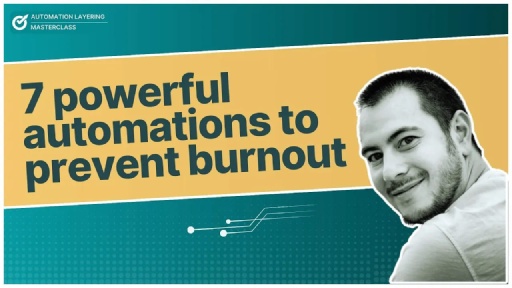
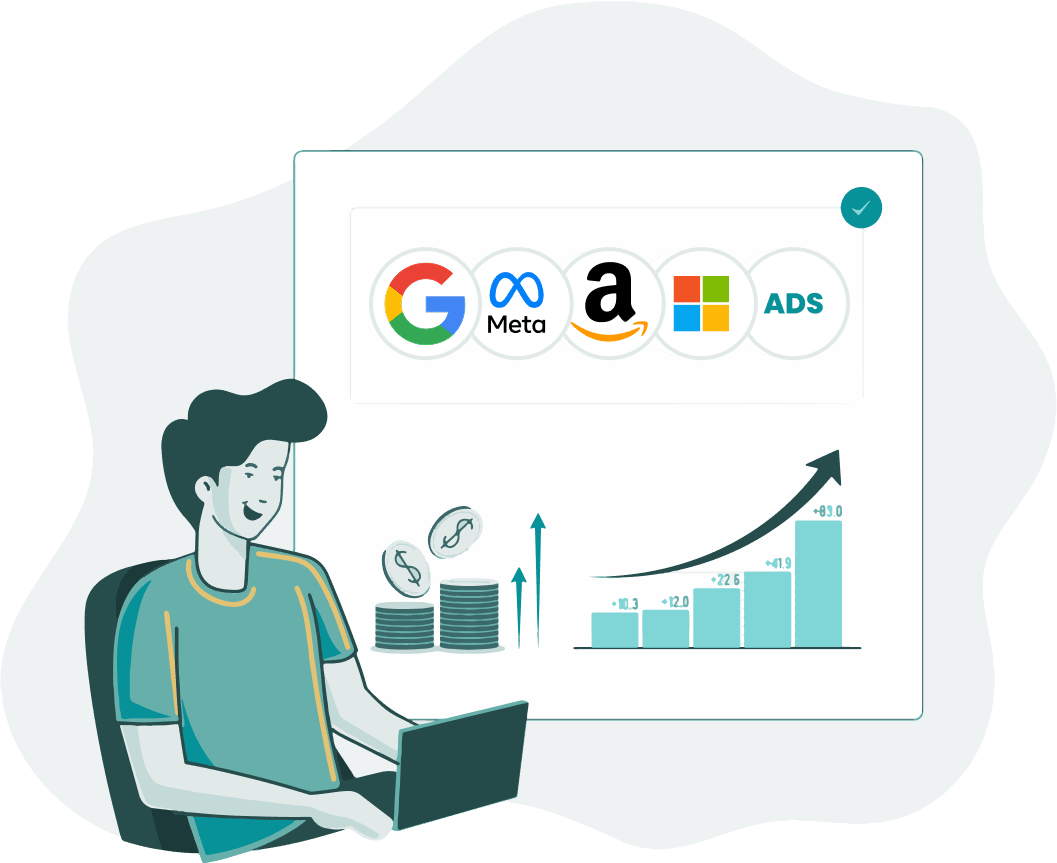
Episode Description
In this episode of Automation Layering Masterclass, you’ll learn how Simone Pardini from Pardini Consultancy has figured out how to use automation layering to get way better results from his shopping campaigns. He categorized all of the products based on performance and used a neural network clustering methodology to label the products better.
You will learn:
- How he built a campaign structure based on client objectives
- How he used neural networks to build clusters of products
- What to do with low-performing products or those with less data
- How he keeps campaigns in sync
- How he puts the right labels in the product feed
Episode Takeaways
Strategically labelling your products based on performance timeframes is a great way to improve your ROI. With the right automation approach, you can direct budget to high-performing products while still testing new products.
Fred and Simone discuss his unique system to keep client campaigns perfectly synchronized with changing product performance and business objectives.
1. How to build a campaign structure aligned with client objectives
Simone Pardini begins by trying to understand key business drivers for his clients. It includes things like conversion rates, product profitability, seasonality, and inventory levels. This is important because although Google’s automated bidding algorithms are effective, they don’t really have enough business context.
For instance, say you have excess inventory that needs to be sold quickly to minimize warehousing costs. However, Google doesn’t know this and ends up optimizing based on conversion rates and ROAS targets alone, potentially ignoring the products you want to sell fast.
Once he understands these objectives, he creates a custom labelling system that reflects these business objectives. He then implements different campaign settings based on the labels.
- A higher budget is allocated for top-performing or high-priority product campaigns
- Bidding is more aggressive for high-priority products
- Narrower targeting for seasonal or low-priority items, so you’re focusing only on the most likely buyers
“If we know that the products labeled as top 15 days are going to be our best products we will spend more money on these products. So we’ll allocate more budget on this campaign and we will set a lower target ROAS. We will allow this campaign to spend more money to find more potential customers.
Now if a product is labeled as top 90 days, we set a lower budget and higher target ROAS so we limit the money wastage on these products” explains Simone
The best part about Simone’s approach is that it automatically adjusts to business changes. Products can move across campaigns according to their performance, campaign settings are adapted based on seasonal fluctuations, and the campaign structure even responds to changes in inventory levels without manual intervention.
2. How can you build product clusters
Instead of simply labelling a product as ‘good performer’ or ‘bad performer’, Simone built a system that categorizes products based on how they perform over a period of 15, 30, 60, and 90 days. This tells you that product performance isn’t always static, and a product that was a top performer 90 days ago should be treated differently from another product that is currently performing at the top.
This is very valuable if your business tends to sell highly seasonal products. With Simone’s system, seasonal products will gradually move from ‘top 15 days’ to the top 30, 60, and finally 90 days as the season passes. This allows gradual budget reduction rather than abruptly stopping the promotion of these products.
“By dividing their products by their daily performance, we kind of account for seasonal changes because the idea is if a product has been selling well in the last seven or 15 days it’s very likely that this product will keep on selling well at the same sales velocity in the next 15 days as well” shared Simone.
3. What to do with low-performing products or ones with less data
Identifying high-performing products and spending money on them is easier. But it can be challenging to determine what you want to do with products that have limited performance data.
What Simone does is he puts specific, quantitative thresholds to identify low exposure products. So you can systematically identify these products without manual review, making this a scalable approach even for businesses with large catalogs.
“The idea was to label all the underperforming products or ones with low exposure. So the products that respond to certain characteristics are generally products that receive less than 10 clicks or less than 10 impressions.
Then label all these products and put them into a separate campaign with extremely low target ROAS and spend some budget on these products in order to run some tests.” said Simone
This tells Google’s algorithm to be more aggressive with these products so you can collect more data and identify potential winners. By continuously gathering data on low-exposure products and regularly evaluating their performance, the system allows products to move to higher-performing categories when they start converting.
4. How to keep your campaigns in sync
Automated synchronization is key to align product labels and campaign structure at scale. Without it you would need to make manual updates and that simply becomes tedious and error-prone when you have thousands of products shifting between performance categories.
“This is done through Optmyzr’s Shopping Campaign Automator. Ad groups are refreshed on a daily basis and the asset groups inside each campaign based on the merchant center feed.
Of course, the feed is also updated on a daily basis. This way whenever there is a new ad group to be added or new products to be added into a new campaign, it is done automatically on a daily basis or on a weekly basis depending on how we set it” explains Simone.
The automation also ensures:
- Consistent campaign structures aligned with your labeling strategy
- System adaptability so that campaigns automatically adjust based on changes in product performance patterns
- Fewer manual reviews and interventions
5. How to put the right labels in the product feed
Simone identifies Optmyzr as a key tool in his system.
“So Optmyzr is really the key tool because it allows you to do this analysis automatically on a daily basis based on a set of rules that are preconfigured.” Simone shares.
Simone emphasizes that the labeling approach must be customized for each business. This customization requires close collaboration with the business to understand their specific goals and constraints, allowing the labeling system to be aligned with broader business objectives rather than just advertising metrics.
He also managed to create a self-improving system where low-exposure products gradually move to higher-performing categories based on data, and previously high-performing products will transition to low-performance categories as their performance declines.
This way, product labels will evolve to reflect the current performance of products. It is a great example of how automation layering bridges the gap between Google’s automated bidding and business objectives.
Tools & Resources
Episode Transcript
Frederick Vallaeys: Hello and welcome to this session of ALM— Automation Layering Masterclass. Today we’re gonna talk about what to do when you have hundreds or even thousands of products in your merchant feed, and you want to get the best possible results for advertising these on Google Shopping or on one of the other search engines.
There are techniques where you can take advantage of Google’s automated bidding, but still get more control over which products show and how much profit you end up making. So that’s the automation layering components. And today on the show we have Simone Pardini who found out how to do this, and he’s gonna explain to us what techniques can get you the most benefits.
So let’s get rolling with this episode.
All right, Simone, welcome to the show. Thank you for joining us. Tell us a little bit about who you are, what you do, and where you’re calling us from.
Simone Pardini: Yeah, that’s perfect. Thank you very much for inviting me. As you say, I’m Simone and by name you can probably tell I’m Italian. Today I’m calling from Italy, although I live in Spain in Barcelona.
But like today I’m calling from Italy.
Frederick Vallaeys: Yeah, Barcelona, beautiful city and in Italy, I think you’re in Tuscany right now, so I’m sure you’re enjoying some lovely Tuscan wines.
Simone Pardini: Yeah absolutely. Lovely wine and lovely food as well.
Frederick Vallaeys: Nice. Hey, so you’ve been doing PPC for for a while now, and you were an ex-Googler working with the agency team, but briefly take people through, like what makes you an expert here?
Simone Pardini: Yeah, so as you say, yeah, since I started, since the beginning of my career I worked in PPC, mainly with Google Ads. I worked for corporations. I was an ex Googler. I supported agencies and then I started freelancing during Covid. The reason why I started freelancing is because I thought that there was so much out there that could be offered in terms of custom solutions for different clients, and especially because I loved working with e-commerce mainly.
So by doing freelancing, I’m really able to work with the business I like, and I’m able to deliver custom solutions. So this is the reason why I started freelancing lately.
Frederick Vallaeys: Nice. And I love that. Custom solutions, right? So let’s talk about that. So sounds like the last couple of years you’ve been focused on e-commerce clients.
And the traditional campaign structure that you see with shopping clients is people will divide the product feed by category and put all the products from a certain category in a shopping campaign or a different performance max campaign, and that’s where they end. But it sounds like you found a way and we’ve seen that way as well.
But you go ahead and explain it, like what’s that way that you can actually do it? That’s structuring a little bit better.
Simone Pardini: Sure. Yeah. As you say most of the campaign structures are based on collections. So there is maybe in the best case scenario, there is a one campaign per each collection or sub collection, but everything really ends there.
Google really does most of the job already with the automated bid strategies. If we talk about target ROAS, this algorithm is already well designed to push the products that are likely to deliver the best results.
There are some additional information that Google doesn’t know, such as the product profitability, for example, or some additional information in terms of stock. Like a client may have a long stock for certain items that they need to push because they need to sell and reduce their internal costs. So of course Google doesn’t have this information and you need to provide Google with this information in order to make really the best out of the investment that advertisers are doing on Google Ads.
The idea here is to label the products into the top performing products and run an internal analysis based on the product performance and basically label these products according to several factors. Use a different set of rules to identify the top performing products, the low performing products, and all the average performing products that are in the middle and assign different labels in order to be able to give Google additional information on what to push, what to advertise, where to invest most of the money in order again, to make the most out of the investment that the advertisers are doing on Google.
Frederick Vallaeys: That makes sense. And so there’s a couple of steps involved in this, right?
It sounds like step number one is figuring out based on the business drivers of the company that you’re working with, what is the ideal campaign structure and what are those divisions? And so you’ve mentioned things like conversion rate, profitability, seasonality, inventory levels, these could all be factors.
And so step one would be figuring that out. Step two would be labeling your merchant feed. And step three would be making sure that based on those labels, the products continuously get allocated to the correct campaigns. Is that how you think about it?
Simone Pardini: Exactly!
Frederick Vallaeys: Yeah. And so then now you did have some sophisticated ways of doing this division, right?
And I think you were talking about having some neural network technology to do the the clustering. But tell us a little bit about the different clusters and the different labels that you decided to attach to products.
Simone Pardini: There is a lot of hype around this point right now about product labeling.
There are different point of views on this on this approach. There are a lot of people that are label the products according to the product performance, such as conversion rate, number of transactions. I found it a little bit limiting in a way because this approach doesn’t take into account the seasonalities.
So basically what I did was to add additional information again, product profitability, so something that we discussed with the client as well as the daily performance of the product. So what I do through Optmyzr of course, is I look at the product performance on a daily basis in the last 90 days, and then according to different rules, these products get labeled as the top products in the last 15 days or the top products in the last 30, 60, or 90 days.
So by dividing the products, by using these the daily performance as well, we kind of account for seasonalities because the idea is if a product has been selling well in the last seven or 15 days, it’s very likely that this product will keep on selling well at the same sales velocity in the next 15 days as well.
Instead, if a product was in the top products, but in the last 90 days, there is a certain likelihood that the seasonality of this product has passed. For example, let’s consider a business selling paddleboards. So paddleboards, at least in Europe is highly seasonal. If we assume that the same advertisers sell other products as well, when we are in October, the paddleboards probably will be labeled as top 90 days, and we won’t allocate as much budget as the products labeled as top 15 days.
Of course, we still want to spend money on paddleboards because maybe people will still buy it, but we want to spend less budget on it, and we want to be a little bit narrower with the targeting so we can adopt a different target ROAS to narrow down the targeting, narrow down the market and still have a decent ROI for these products that are out of season.
Frederick Vallaeys: Very cool. Yeah. I love how you do like multiple date ranges to see that waning seasonality and slowly ramp down without completely turning it off. Now what do you do about products that may not be getting a ton of data or low performing products?
Simone Pardini: This has been really the major challenge because it’s easy to identify the top performing products, and it’s easy to spend money on the top performing products, but how do we identify the products that performed as average or don’t have enough exposure? And how much money do we need to invest in these product? What is the target ROAS that we need to set on these products?
So the idea was to label all the underperforming, all the products with low exposure. So products that respond to certain characteristics that are generally products that receive less than 10 clicks or less than 10 impressions. Okay? So label all these products and put them into a separate campaign with extremely low target ROAS and spend some budget on these products in order to run some tests.
Of course, if these products start getting transactions, then they will be labeled as top 15, top 30, top 60 days. And over time, the number of products with low exposure will reduce and the number of products labeled as top will increase thanks to this strategy.
Frederick Vallaeys: That makes sense. And so what you basically are doing is provide fluidity. A product doesn’t have to get stuck with one label, but it can always evolve.
Simone Pardini: Yeah, absolutely. So products really jump from a label to another according to how often the analysis is done.
And this is really, this is the beauty of this, because we don’t really have to manually change things. We need to run a good analysis on the products. We need to understand what are the best products, and this is like the most time consuming part. Then once this is done and the analysis is performed on a daily basis, then products will jump automatically from a label to another and by using the Google Ads algorithm, then the performance is optimized because again, we’ll spend most of the money on the products that are labeled as top 15 days, which will deliver the highest ROAS, which will target the highest market possible. So the investment is really surgical in a way. And the other part of the investment is to test new products.
Frederick Vallaeys: And this would of course be very difficult to do manually. So I think the secret sauce lies in the grouping that you do.
So you’ve explained what you do, but it could be different for different clients or different scenarios and once you’ve got that figured out, then the trick becomes how do you get this done on a daily basis or even more frequently without having to do it manually? And so that’s why we’re talking about automation layering. And that’s where tools like Optmyzr then come in. And I believe you were using another tool called Catchr.
So now you basically use these tools to put the right labels in the product feed. So talk a little bit about that process.
Simone Pardini: Yeah, sure. So Optmyzr is really the key because it allows to do this analysis automatically on a daily basis based on a set of rules that are pre-configured.
Once the analysis is done on a daily basis, then all the analysis is put on a spreadsheet automatically. And then this spreadsheet is then linked to the merchant center where the labels are applied. Of course, as you say, doing this analysis manually, that would be impossible because if we talk about a business with 2000 different products, running this analysis on a daily basis probably would mean that I spend eight hours a doing analysis.
But instead with Optmyzr, this is done overnight and is automatically applied in the merchant center, which is really the beauty of that. By using the custom labels, we can create the shopping or performance max campaigns and everything is automated there.
Frederick Vallaeys: Yeah I think you’ve actually taken the tool capability one step further. So we have some baked in capabilities in the shopping automator that will let you set basic conditions about grouping things by ROAS, for example. But it sounds like you’ve taken it one step further by using the rule engines so that you can start really customizing, and that’s where the secret sauce and your value add comes in, right?
So if people wanna work with you and figure out like, hey what’s Simone’s way of grouping things, that does require a little bit more sophistication and that’s where the rule engine comes in. So that’s really fantastic to hear that you’ve you’ve taken the tool to the limit of what they can do and drive performance with that.
Simone Pardini: Yes. Yeah. As you say the approach is totally custom, really, because every business is different. And again many businesses have problem with stock. Many times the stock means extra stock, mean extra costs or that every product has a different margin, so we need to take this into account when we run the analysis, and that’s why it’s so important to have discussion with businesses really.
Also you mentioned Catchr earlier. The fact that with Optmyzr we can create these custom labels, like top 15 days, top 30 days, is really helpful because it helps to drive performance across different channels as well as across different campaigns. Not only Performance Max and shopping campaigns, which are most of the time, the main drivers of performance, of course.
But if we basically, if we use Catchr, we can download the Merchant Center data into a Google spreadsheet, then we can use that to build DSA feeds, and then we can build a DSA campaign using the top 15 days only. So we can invest money on search through a DSA campaign only on the top performing products.
That’s why I’m saying that Optmyzr is at the core and then Catchr really helps to expand the targeting.
Frederick Vallaeys: Nice. I love that. Really taking automation layering to heart there. Okay but we’ve talked about figuring out what are the groupings, how to put on the labels.
Let’s talk briefly though, how do you make sure that the campaigns are constantly in sync based on the labels as they keep evolving? Obviously that’s not something you do manually, right? So talk a little bit about that.
Simone Pardini: Correct. Good point. Still this is done through Optmyzr. It was the old campaign refresher. Can’t remember the name now, is it like the campaign manager.
Frederick Vallaeys: Yeah. Shopping campaign automator, I think.
Simone Pardini: Yes. Shopping campaign automator. Basically is a future in built-in Optmyzr that on a daily basis, refreshes the ad groups and the asset groups inside each campaign based on the merchant center feed, and of course the feed is updated on a daily basis. So whenever there is a new ad group to be added or new products to be added into a new campaign, this is done automatically on a daily basis or on a weekly basis.
Depends on how we set it, but yes, good point.
Frederick Vallaeys: A lot of customers, they use the shopping campaign builder and automator tools to basically say, okay, we have a new product that was not in the feed yesterday, but it is in there today.
And then through our tool, you’ve specified what is the structure. So when do you need a campaign? When do you need a product group? When do you need an ad group, depending on whether you’re using PMax, right? And so then it knows, okay, this new product logically fits in this place, and then it creates a new campaign, a new ad group, a new product group, whatever is necessary.
But what’s cool about what you’ve done is not just about new products, it’s about existing products that now have a different label because all of a sudden they went from low volume, we didn’t know anything to what you said. All of a sudden we’ve boosted the volume and it’s a top 15 product, so it gets moved into the correct structure and it’s automatically running and it’s taken care of for you.
Simone Pardini: Yeah, exactly. One additional thing is that if a new asset group gets created into a PMax campaign, then still in Optmyzr, I’ve got the notification that maybe that new asset group is missing the audience signals. So I know that I need to go into the account and I need to add all the assets and all the audience signals.
This is something that needs to be done manually, but at least I’ve got the notification that I need to do it.
Frederick Vallaeys: Yeah. Great. Okay, so you do all of this hard work. Let’s talk a little bit about the results. So clearly you’ve been doing this for a while, so it must be paying off. So let me pop some numbers on the screen and talk us a little bit through what you’ve been seeing.
Simone Pardini: Yeah. These are the results of these labels in the last 90 days. Basically, what we can see here is that most of the conversions are actually happening in the products labeled as top 15 days, so like the vast majority, so 409 conversions in the last 90 days have been driven by this top 15 days label.
And the second top performer is the top 30, top 60 and top 90. So basically, as we can see here, these top 15, 30, 60, 90 days work as they should. So most of the conversions are happening here, and then, there is a gradual reduction.
If we look at the cost, we have really the same graph. Most of the cost has gone here in top 15 days, top 30, top 60. And then we have products that are not labeled. As I said earlier, products that are not labeled or low exposure are the products that we can’t really determine if they are good or bad, so we need to, we still need to spend some money on those to be able to label them correctly.
If we look at the conversion rate, we still have the same results probably here between see top 60 and top 30 days. They’re inverted, but the results are very similar. From my point of view, this is the proof that if we label the products correctly, if we identify the top performing products in the last 15 days, that we keep on spending money on those, we really reduce the money wastage and we increase the results. We increase the return on investment. We invest on money with the highest conversion rate.
Let’s have a look at ROAS. Okay, so here again have a similar graph, inverted between top 30 and top 15 days, but that’s another point of view.
But again, the vast majority of the conversions, the vast majority of the revenue is coming from these top 15 days products.
Frederick Vallaeys; And of course one of the things that maybe be glossed over a little bit is that as you’ve put in place different campaigns for top 15, top 30, you can set different budgets for them, you can have different bid strategies.
Even if you’re doing target ROAS for all of them, you can have different targets. And so that’s what affords that flexibility where you are connecting your business goals with the Google ads automations. So that’s really what gives you the power to steer the performance and the results in the direction that you want.
Simone Pardini: Exactly. And again, if we know that the products labeled as top 15 days are gonna be our best products, we will spend more money on these products. So we’ll allocate more budget on this campaign and we’ll set a lower target ROAS. So we will allow this campaign to spend more money, find more potential customers based on these top performing products.
And instead, if a product is labeled as top 90 days, we set lower budget and higher target ROAS. So we limited the money wastage on these products.
Frederick Vallaeys: Very nice. Simone, this this has been fantastic. Thank you for sharing how you do this. Now you said you’re based in Spain, you’re originally from Italy, but you work with customers from pretty much all over the world, right? If anyone wanted to.
Simone Pardini: Yes, exactly. Exactly. Mainly I work with businesses in the United Kingdom. But I work with businesses as well in Australia, United States, so all the English speaking countries.
Frederick Vallaeys: Okay, great. And now if people wanna get ahold of you, what’s the best place to find you?
Simone Pardini: On LinkedIn. That is probably the best place because I’m always connected on LinkedIn, so I can answer straight away.
Frederick Vallaeys: Great. Simone Pardini from Pardini Consulting. We’ll put that URL, the LinkedIn profile in the show notes. But Simone, this has been great. So thanks again for sharing. Thanks everyone for watching and learning about automation layering.
If you want to keep learning more about this, we have new episodes coming all the time. Hit the subscribe button there at the bottom and we’ll keep you notified whenever we have a new episode. Thanks again for watching. Thank you, Simone and have a great day.

